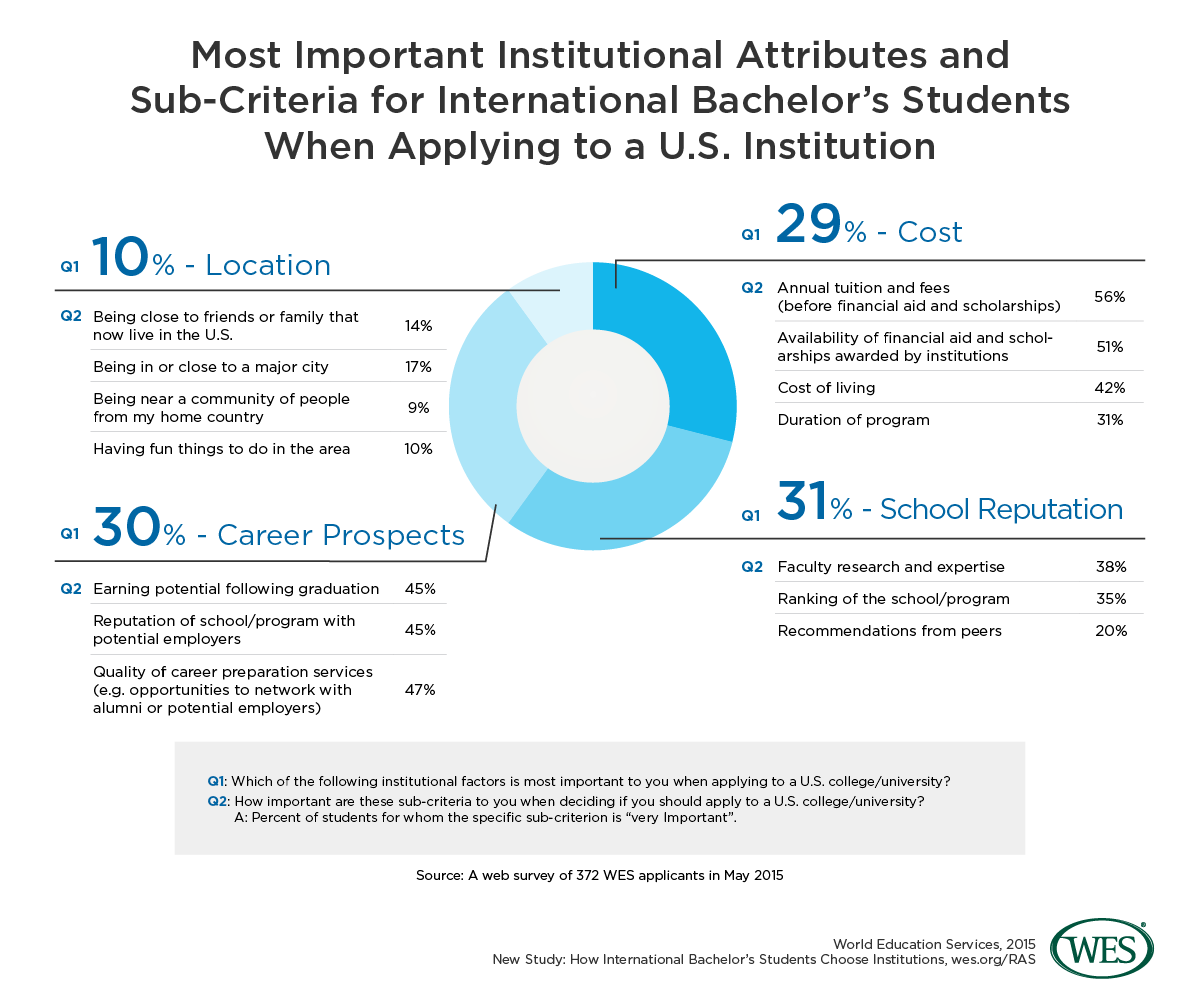Alejandro Ortiz, Research & Advisory Services, WES
During the 2013-2014 academic year, the growth of international students at the bachelor’s level outpaced that of master’s students, increasing 54% from 2008-2009 to 2013-2014, compared to 26% during the same period for master’s students (IIE data). This Mobility Monitor will help U.S. institutions deepen their understanding of the decision-making process of prospective international bachelor’s students by examining which institutional attributes they value most when applying to U.S. colleges and universities. We also unveil key differences in the perceptions of the institutional attributes between bachelor’s and master’s students.
To address this topic, WES recently surveyed 372 prospective international bachelor’s students and 2,388 at the master’s level [1] and asked them to choose the most important factor when deciding where to apply among the following institutional attributes: school reputation, career prospects, location and cost. In order to dig deeper into which aspects of the institutional attributes most concern future bachelor’s students, the survey also asked them to rate the relative importance of different sub-criteria (see Figure):
 [2]According to our findings, 31% of bachelor’s students selected school reputation as the most important factor in deciding where to apply. This is particularly significant for Highfliers and Explorers (35%), who have high financial resources, according to our segmentation framework [3]. While faculty research and expertise is rated as a very important sub-criterion of school reputation by 38% of bachelor’s students, the percentage is much lower than master’s students (47%), indicating different needs of international students by level.
[2]According to our findings, 31% of bachelor’s students selected school reputation as the most important factor in deciding where to apply. This is particularly significant for Highfliers and Explorers (35%), who have high financial resources, according to our segmentation framework [3]. While faculty research and expertise is rated as a very important sub-criterion of school reputation by 38% of bachelor’s students, the percentage is much lower than master’s students (47%), indicating different needs of international students by level.
In terms of the return on investment for a U.S. education, bachelor’s students are more likely to select cost as the most important attribute compared to master’s students (29% vs.15%), while for master’s students, the emphasis is more on career prospects (48% vs. 30%). These different perceptions can be largely explained by differences in career experience; there are more bachelors’ students than master’s students who have no work experience (49% vs. 30%) and who are not currently employed (65% vs. 47%).
Differences also emerge between bachelor’s and master’s students regarding location. Bachelor’s students are less likely than master’s students to rate being in a large city as “very important” (17% vs. 21%), but they are more likely than master’s students to choose the other three sub-criteria of location (being close to friends and family, being near a community of people from my home country, and having fun things to do in the area) as “very important.” This finding suggests that bachelor’s students need more from their environment and emphasizes the importance of promoting activities that connect the students to their community [4].
The research illustrates that there are a wide range of student motivations, needs and preferences between education levels. To attract and retain the best-fit international bachelor’s students for your campus, colleges and universities should understand bachelor’s student preferences and move from hunches to informed international recruitment strategies.
Previous Mobility Monitors
- Saudi Students Flock to a Diverse Set of U.S. Institutions [5]
- Increasingly Mobile and Educated: The Future of Canadian Immigration [6]
- Can U.S. Universities Compete in the Southeast Asian Transnational Education Market? [7]
WES in the News
- Google Reveals Top Searches for Overseas Student [8]s [8], BBC
- International Rankings are not Comprehensive [9], Hindustan Times
- China Remains Attractive to Int’l Students Despite Slowdown [10], China Radio International (CRI)
